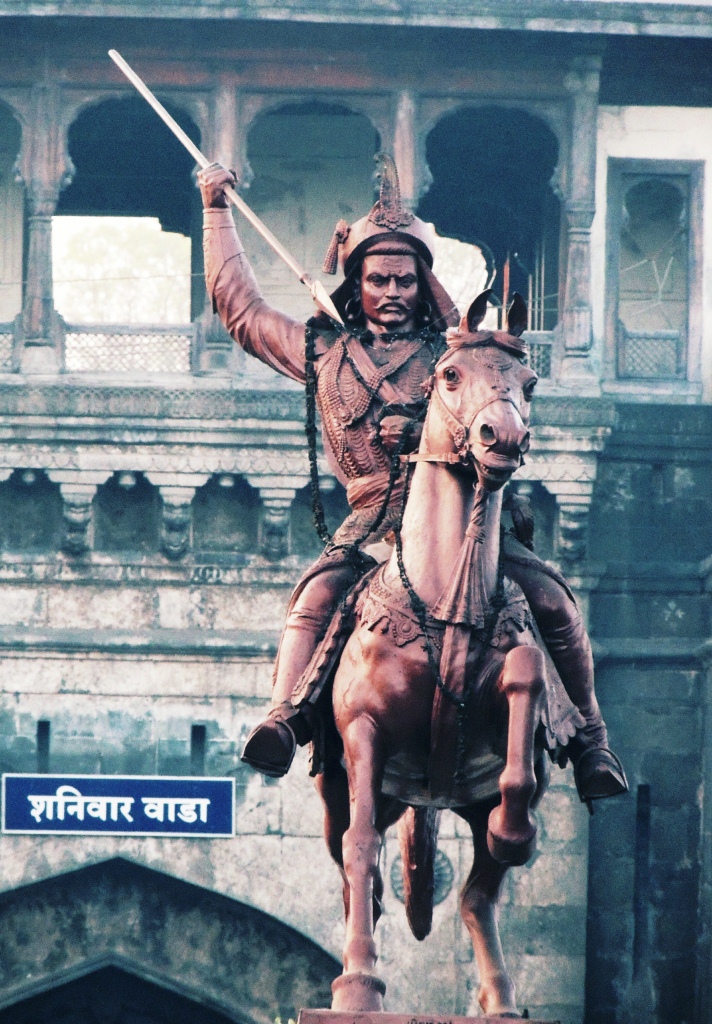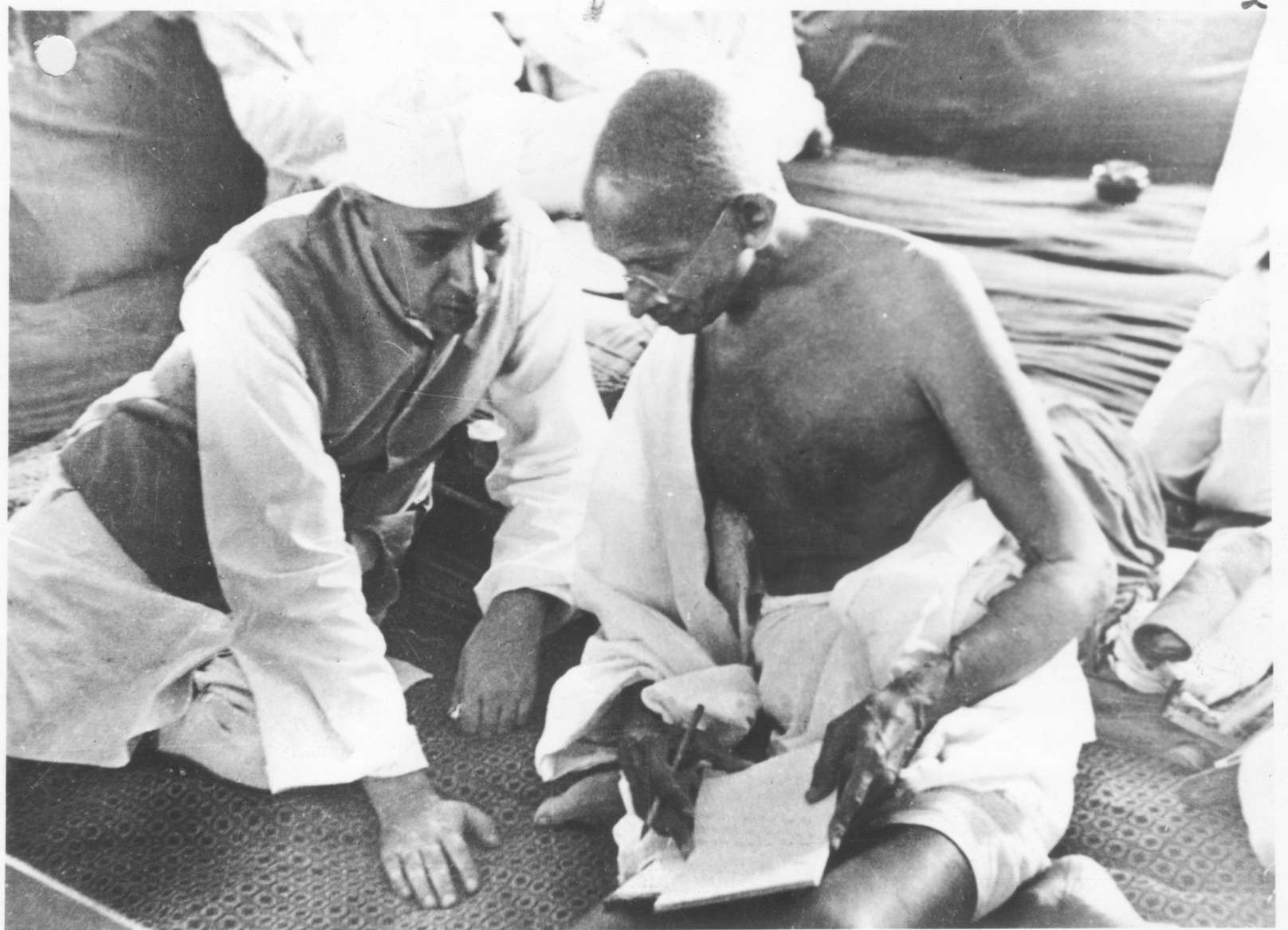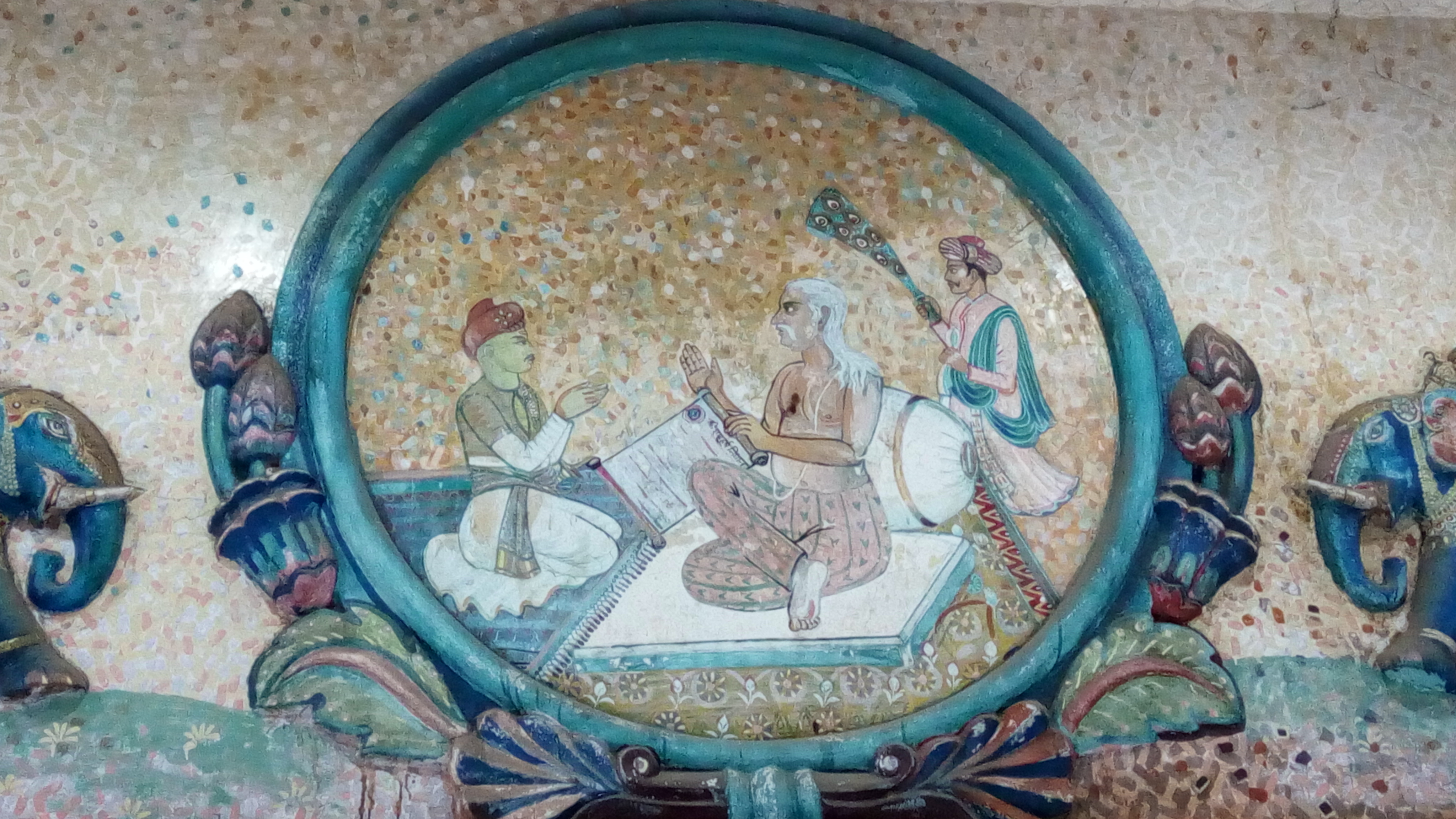|
Gharge-Desai (Deshmukh)
Gharge-Desai (Deshmukh) were the rulers of one of the oldest Maratha princely states of Nimsod in Satara District. History Rana Ratansingh Alias Ranoji from Rajputana (Rajasthan) and ancestor of the family Shrimant Kalojiraje Gharge-Desai-Deshmukh received the Sur-Deshmukhi of Nimsod along with 72 villages from Muhammad bin Tughluq, the sultan of Delhi in 1342 during his peninsular campaign. In 1536 Santajiraje Gharge-Desai-Deshmukh received various fiefs from the Ibrahim Adil Shah I ruler of Bijapur Sultanate in the Shirol area, and in 1615 Shrimant Ramraoraje from Ibrahim Adil Shah II in Raibaj and Kittur and remained one of the largest Deshmukhs of Adil Shahi. During the Maratha rule, the family served as the important milestone of the Maratha Empire with blood relationships with various ruling families of those days, were in forefront in continuous War of 27 years between 1682 and 1707 that resulted in the end of the Mughal Empire in India and brought most of the sub ... [...More Info...] [...Related Items...] OR: [Wikipedia] [Google] [Baidu] |
Princely State
A princely state (also called native state or Indian state) was a nominally sovereign entity of the British Raj, British Indian Empire that was not directly governed by the British, but rather by an Indian ruler under a form of indirect rule, subject to a subsidiary alliance and the suzerainty or paramountcy of the the Crown, British crown. There were officially 565 princely states when India and Pakistan became independent in 1947, but the great majority had contracted with the viceroy to provide public services and tax collection. Only 21 had actual state governments, and only four were large (Hyderabad State, Mysore State, Kashmir and Jammu (princely state), Jammu and Kashmir State, and Baroda State). They Instrument of accession, acceded to one of the two new independent nations between 1947 and 1949. All the princes were eventually pensioned off. At the time of the British withdrawal, 565 princely states were officially recognised in the Indian subcontinent, apart from t ... [...More Info...] [...Related Items...] OR: [Wikipedia] [Google] [Baidu] |
Maratha
The Marathi people (Marathi: मराठी लोक) or Marathis are an Indo-Aryan ethnolinguistic group who are indigenous to Maharashtra in western India. They natively speak Marathi, an Indo-Aryan language. Maharashtra was formed as a Marathi-speaking state of India in 1960, as part of a nationwide linguistic reorganization of the Indian states. The term "Maratha" is generally used by historians to refer to all Marathi-speaking peoples, irrespective of their caste; however, now it may refer to a Maharashtrian caste known as the Maratha. The Marathi community came into political prominence in the 17th century, when the Maratha Empire was established under Chhatrapati Shivaji; the Marathas are credited to a large extent for ending Mughal rule over India. History Ancient to medieval period During the ancient period, around 230 BC, Maharashtra came under the rule of the Satavahana dynasty, which ruled the region for 400 years.India Today: An Encyclopedia of Life in the R ... [...More Info...] [...Related Items...] OR: [Wikipedia] [Google] [Baidu] |
Shaniwar Wada
Shaniwar Wada is a historical fortification in the city of Pune, India. Built in 1732, it was the great seat of the Peshwas of the Maratha Empire until 1818. Following the rise of the Maratha Empire, the palace became the center of Indian politics in the 18th century. The fort itself was largely destroyed in 1828 by an unexplained fire, but the surviving structures are now maintained as a tourist site. History The Shaniwar Wada was normally the seven-story capital building of the Peshwas of the Maratha Empire. It was supposed to be made entirely of stone but after the completion of the base floor or the first story, the people of Satara (the national capital) complained to the Chatrapati Shahu Maharaj(King) saying that a stone monument can be sanctioned and built only by the king himself and not the Peshwas. Following this, an official letter was written to the Peshwas stating that the remaining building had to be made of brick and not stone. Even today if you visit and see ... [...More Info...] [...Related Items...] OR: [Wikipedia] [Google] [Baidu] |
Quit India Movement
The Quit India Movement, also known as the August Kranti Movement, was a movement launched at the Bombay session of the All India Congress Committee by Mahatma Gandhi on 8th August 1942, during World War II, demanding an end to British rule in India. After the failure of the Cripps Mission to secure Indian support for the British war effort, Gandhi made a call to ''Do or Die'' in his Quit India movement delivered in Bombay on 8 August 1942 at the Gowalia Tank Maidan. The All India Congress Committee launched a mass protest demanding what Gandhi called "An Orderly British Withdrawal" from India. Even though it was at war, the British were prepared to act. Almost the entire leadership of the Indian National Congress was imprisoned without trial within hours of Gandhi's speech. Most spent the rest of the war in prison and out of contact with the masses. The British had the support of the Viceroy's Council, of the All India Muslim League, the Hindu Mahasabha, the princely state ... [...More Info...] [...Related Items...] OR: [Wikipedia] [Google] [Baidu] |
Salt Satyagraha
The Salt March, also known as the Salt Satyagraha, Dandi March and the Dandi Satyagraha, was an act of nonviolent civil disobedience in colonial India led by Mahatma Gandhi. The twenty-four day march lasted from 12 March to 6 April 1930 as a direct action campaign of tax resistance and nonviolent protest against the British salt monopoly. Another reason for this march was that the Civil Disobedience Movement needed a strong inauguration that would inspire more people to follow Gandhi's example. Gandhi started this march with 78 of his trusted volunteers. The march spanned , from Sabarmati Ashram to Dandi, which was called Navsari at that time (now in the state of Gujarat). Growing numbers of Indians joined them along the way. When Gandhi broke the British Raj salt laws at 8:30 am on 6 April 1930, it sparked large scale acts of civil disobedience against the salt laws by millions of Indians. After making the salt by evaporation at Dandi, Gandhi continued southward along t ... [...More Info...] [...Related Items...] OR: [Wikipedia] [Google] [Baidu] |
Indian National Congress
The Indian National Congress (INC), colloquially the Congress Party but often simply the Congress, is a political party in India with widespread roots. Founded in 1885, it was the first modern nationalist movement to emerge in the British Empire in Asia and Africa. From the late 19th century, and especially after 1920, under the leadership of Mahatma Gandhi, the Congress became the principal leader of the Indian independence movement. The Congress led India to independence from the United Kingdom, and significantly influenced other anti-colonial nationalist movements in the British Empire. Congress is one of the two major political parties in India, along with its main rival the Bharatiya Janata Party. It is a "big tent" party whose platform is generally considered to lie in the centre to of Indian politics. After Indian independence in 1947, Congress emerged as a catch-all and secular party, dominating Indian politics for the next 20 years. The party's first prime minister ... [...More Info...] [...Related Items...] OR: [Wikipedia] [Google] [Baidu] |
Zamindar
A zamindar ( Hindustani: Devanagari: , ; Persian: , ) in the Indian subcontinent was an autonomous or semiautonomous ruler of a province. The term itself came into use during the reign of Mughals and later the British had begun using it as a native synonym for “estate”. The term means ''land owner'' in Persian. Typically hereditary, from whom they reserved the right to collect tax on behalf of imperial courts or for military purposes. During the period of British colonial rule in India many wealthy and influential zamindars were bestowed with princely and royal titles such as ''maharaja'' (great king), ''raja/rai'' (king) and ''nawab''. During the Mughal Empire, zamindars belonged to the nobility and formed the ruling class. Emperor Akbar granted them mansabs and their ancestral domains were treated as jagirs. Some zamindars who were Hindu by religion and brahmin or kayastha or kshatriya by caste were converted into Muslims by the Mughals. During the colonial era, the ... [...More Info...] [...Related Items...] OR: [Wikipedia] [Google] [Baidu] |
Third Anglo-Maratha War
The Third Anglo-Maratha War (1817–1819) was the final and decisive conflict between the English East India Company and the Maratha Empire in India. The war left the Company in control of most of India. It began with an invasion of Maratha territory by British East India Company troops, and although the British were outnumbered, the Maratha army was decimated. The troops were led by Governor General Hastings, supported by a force under General Thomas Hislop. Operations began against the Pindaris, a band of Muslim mercenaries and Marathas from central India. Peshwa Baji Rao II's forces, supported by those of Mudhoji II Bhonsle of Nagpur and Malharrao Holkar III of Indore, rose against the East India Company. Pressure and diplomacy convinced the fourth major Maratha leader, Daulatrao Shinde of Gwalior, to remain neutral even though he lost control of Rajasthan. British victories were swift, resulting in the breakup of the Maratha Empire and the loss of Maratha independence. ... [...More Info...] [...Related Items...] OR: [Wikipedia] [Google] [Baidu] |
Tarabai
Tarabai Bhosale (Pronunciation: Help:IPA/Marathi, [t̪aːɾabaːi]; ''née'' Mohite) was the regent of the Maratha Empire of India from 1700 until 1708. She was the queen of Rajaram Chhatrapati, Rajaram Bhonsale, and daughter-in-law of the empire's founder Shivaji. She is acclaimed for her role in keeping alive the resistance against Mughal Empire, Mughal occupation of Maratha territories after the death of her husband, and acting as the regent during the minority of her son, Shivaji II. Family and early life Tarabai came from Mohite (clan), Mohite clan. She was daughter of Commander-in-Chief Hambirrao Mohite of Shivaji Maharaj, Shivaji, the founder-king of the Maratha empire. Hambirrao's sister Soyarabai was the queen of Shivaji and mother of his younger son Rajaram I. Tarabai married Rajaram at the age of 8 in 1682, becoming his second wife. After the death of his step-brother and predecessor Sambhaji, Rajaram ruled the Maratha Empire from 1689 to 1700, when his first wife ... [...More Info...] [...Related Items...] OR: [Wikipedia] [Google] [Baidu] |
Chattrapati Shahu
Chhatrapati Shahu Bhosale I (Pronunciation: �aːɦuː CE) was the fifth Chhatrapati of the Maratha Empire founded by his grandfather, Chhatrapati Shivaji Maharaj. Born into the Bhonsle family, he was the son of Chhatrapati Sambhaji Maharaj, Shivaji Maharaj's eldest son and successor. He was captured at a very young age and held captive by the Mughals till the death of the Mughal emperor Aurangzeb. At that time, he was released from captivity in the hope of keeping the Marathas locked in an internecine struggle. Under Chhatrapati Shahu Maharaj's reign, Maratha power and influence extended to all corners of the Indian subcontinent, which eventually turned into a strong Maratha Empire during his time. After his death, his ministers and generals such as the Peshwas, Bhonsle of Nagpur, Gaikwad, Shinde and Holkar carved out their own fiefdoms and turned the empire into a confederacy. Early life Shahu, as a seven year old child, was taken prisoner along with his mother in 168 ... [...More Info...] [...Related Items...] OR: [Wikipedia] [Google] [Baidu] |
Saranjamdar
A Saranjam is a grant of land (initially non-hereditary) for maintenance of troops or for military service found among the Maratha, Rajput, Chandraseniya Kayastha Prabhu, Pathare Prabhu, and Kunbi communities in Maharashtra and the former Maratha administered regions of India, including territories in present-day Karnataka and Madhya Pradesh. The grant was bestowed by a king or regional ruler of a princely state. The Saranjam system may be a form of to the Jagir (feudatory estate) system. The land was mostly in the form of a rural Watan (rights given in reward for previous service or merit) or Jagir, its owner being entitled to extract revenue from the villages included in the territory. Saranjamdar was the title given to the landlord or holder of a Saranjam. It was usually bestowed on that person for heroic deeds in the military field, thus most Saranjamdars were former military officers. He may be a jagirdar, always ranking as a vassal. Political Saranjam Rajaram Bhonsle ( ... [...More Info...] [...Related Items...] OR: [Wikipedia] [Google] [Baidu] |







